Original | Odaily Planet Daily (@OdailyChina)

The U.S. federal government shutdown lasting 43 days has ended, but the anticipated rebound did not materialize—this morning, the crypto market instead experienced another wave of correction.
According to OKX market data, BTC has fallen below the $100,000 mark, hitting a low of just below $98,000, with a 24H decline of 3.01%, marking a new low since May 8 of this year; ETH has dropped below $3,200, reaching around $3,150, with a 24H decline of 7.44%, SOL down 6.49%, and BNB down 4.07%.
Aside from BTC, ETH, SOL, and BNB, the altcoin market continues to decline. According to Quantifycrypto data, over 90% of the top 100 cryptocurrencies by market capitalization have been in a downtrend over the past 24H.
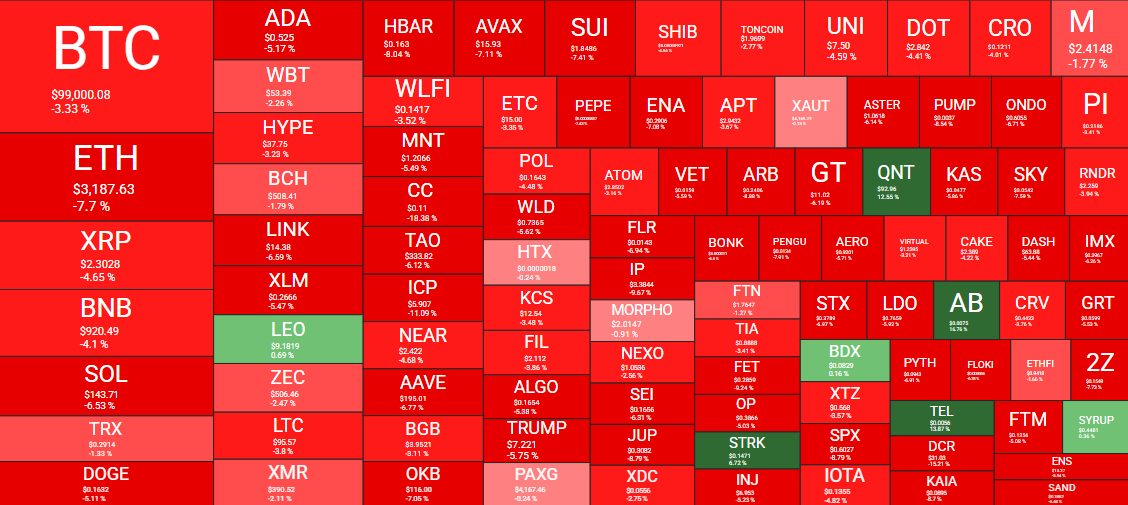
24H price fluctuation data of the top 100 cryptocurrencies by market capitalization
In the derivatives market, according to Coinglass data, the total liquidation amount across the network in the past 12 hours reached $615 million, with long positions accounting for $527 million. BTC and ETH were the hardest hit, with liquidation amounts of $228 million and $178 million, respectively.
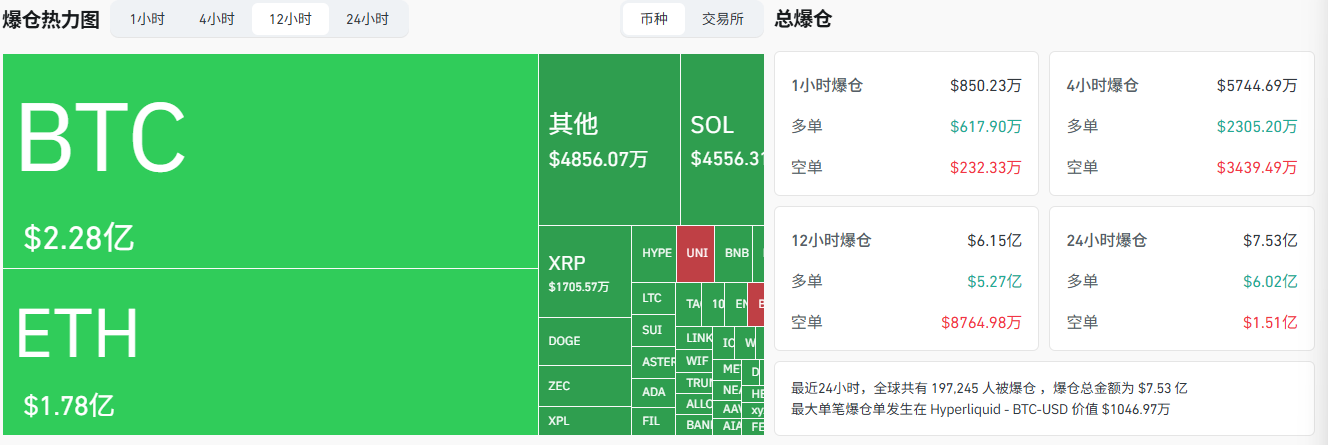
Liquidation data in the crypto derivatives market
According to CoinMarketCap data, the fear and greed index continues to decline, remaining in a state of "extreme fear" for over a week, with market sentiment dropping to a freezing point.
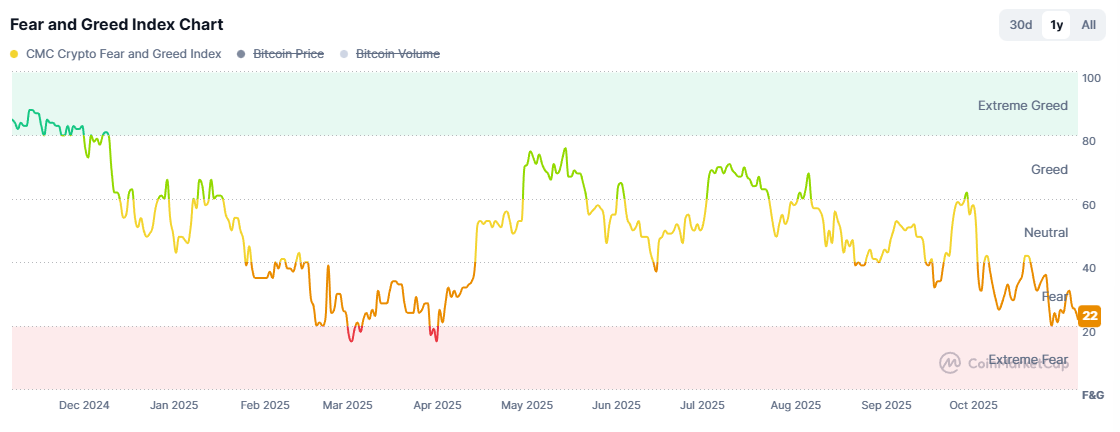
Fear and greed index
Market sentiment is continuously deteriorating, and morale is clearly unstable. Where is the problem?
BTC and ETH spot ETF data show multiple net outflows
Spot ETF data is an important indicator for observing market funds. According to SoSoValue data, since October 29, BTC spot ETFs have seen multiple large net outflows. Notably, on November 4, the single-day net outflow reached $577 million. Although there were brief net inflows recorded on November 6 and November 11 (with a net inflow of $1.15 million on November 10, which can be ignored), overall, funds have continued to show a net outflow trend since November.
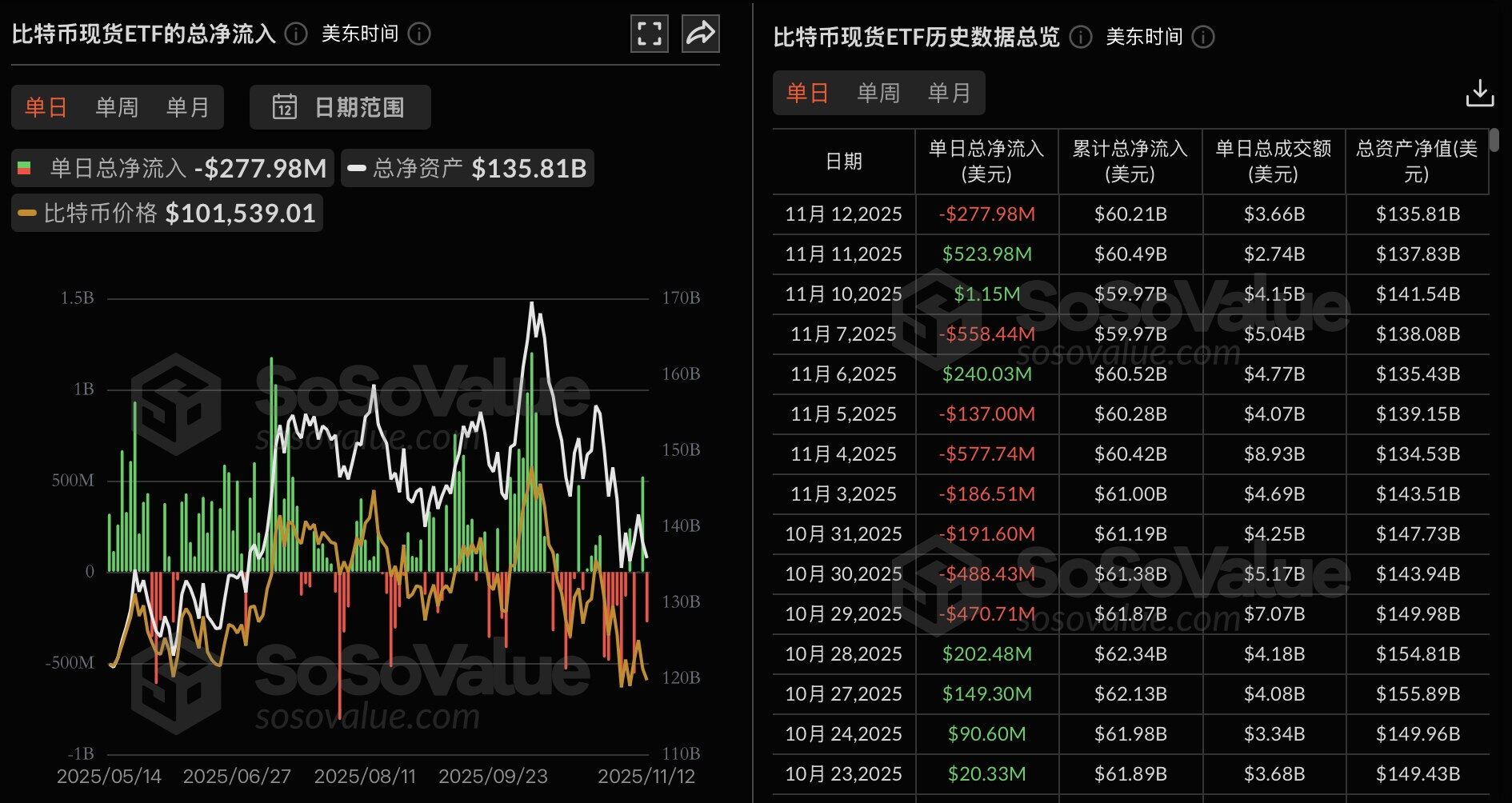
BTC spot ETF data
As for ETH spot ETFs, the recent performance is even less optimistic. Data shows that since October 29, except for the net inflow of funds on November 6 (with a net outflow of 0 on November 10), all other days have seen net outflows, with multiple single-day net outflows exceeding $100 million.
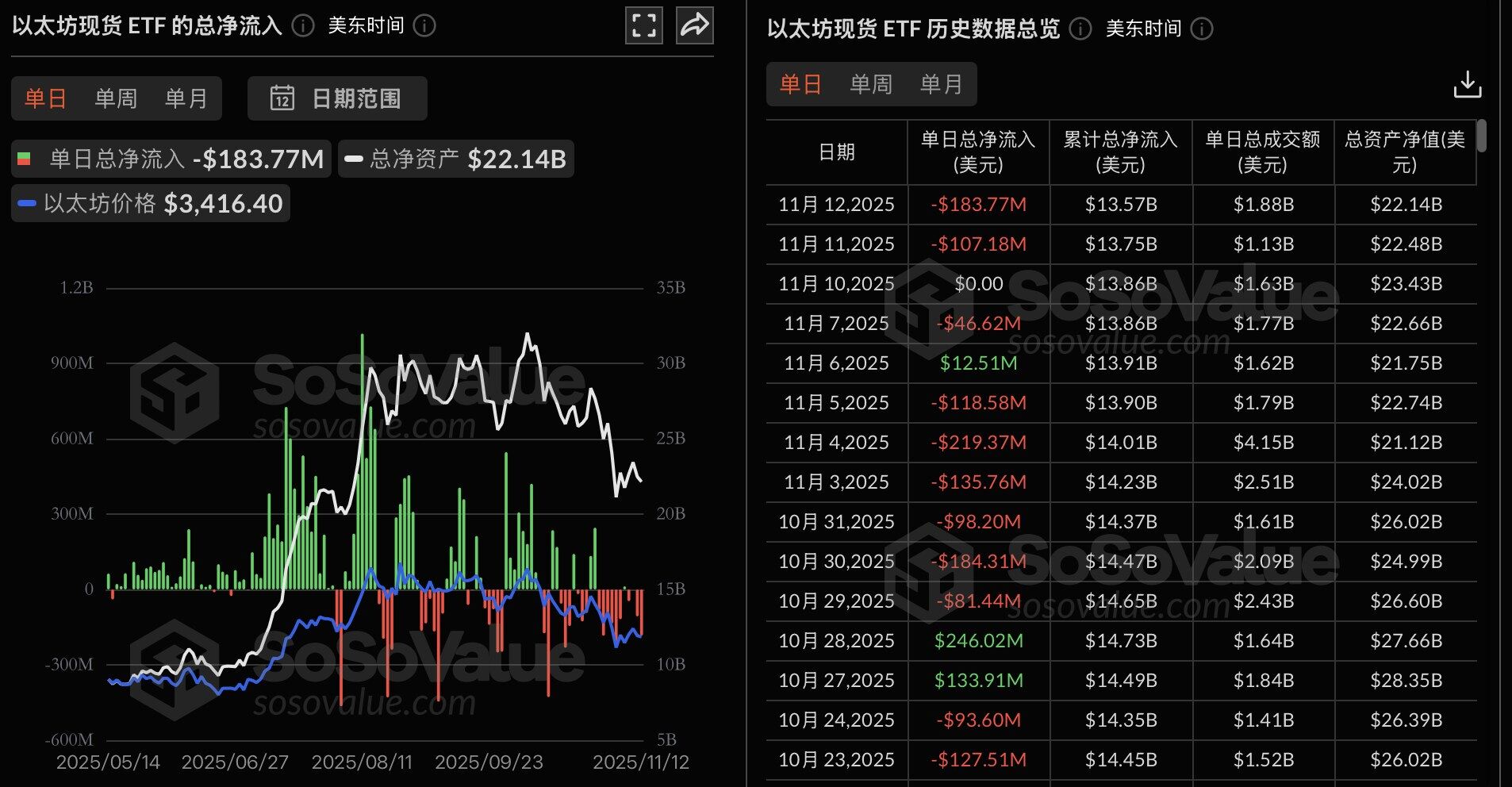
ETH spot ETF data
Expectations for Fed rate cuts have weakened
The latest "Fed Whisperer" report indicates that there are rare and severe divisions within the Federal Open Market Committee (FOMC), directly undermining market confidence in the subsequent rate cut path, which has become an important reason for the recent decline in risk appetite.
First, there is a rift in decision-makers' views on the necessity of rate cuts—hawks emphasize that inflationary pressures still pose an upside risk and advocate for pausing rate cuts; doves worry about a sudden drop in job growth, believing that not continuing to ease will drag down the economy. The government shutdown has led to a temporary interruption of official economic data, further widening the divide between the two sides.
Second, there are completely different judgments surrounding three core issues, creating uncertainty in policy outlook:
- Is inflation caused by tariffs one-time or persistent?
- Is the slowdown in employment due to weakened demand or insufficient labor supply?
- Are current interest rates still "restrictive"?
The lack of consensus on these three points also means that the conditions and pace for future rate cuts have become unclear.
Finally, although the market previously widely bet that the Fed would continue to cut rates in December, the internal debate is now intense, with even Powell himself actively lowering market expectations at a press conference, indicating that the committee is in a state of "difficulty in reaching a consensus." Whether or not to continue cutting rates in December now entirely depends on the upcoming data, rather than a predetermined path.
Because of this, the originally clear rate cut roadmap is becoming unclear. Policy uncertainty has led to a decline in risk appetite, becoming an important driver of the recent weakening market sentiment, capital seeking safety, and pressure on crypto assets.
The narrative of DAT (Crypto Treasury) may have turned negative
Regulation is tightening comprehensively, squeezing the survival space of DAT
Bloomberg reports that three major stock exchanges in the Asia-Pacific region, including the Hong Kong Stock Exchange, are resisting the trend of listed companies hoarding cryptocurrencies as a core business. The Hong Kong Stock Exchange has recently questioned the strategic plans of at least five companies transitioning to DAT companies, citing violations of regulations prohibiting the holding of large amounts of liquid assets. Indian and Australian exchanges have also taken similar stances, providing greater resistance to listed companies transitioning to crypto treasury (DAT) companies.
The market may have sensed the bubble in the corporate hoarding of cryptocurrencies
During the craziest times of 2024, the so-called "DAT effect" has almost turned into a guaranteed capital game: any listed company that announces it will start allocating Bitcoin can instantly boost its stock price, regardless of whether its main business is related to crypto. As a result, more and more companies treat "buying BTC, ETH, SOL" as the cheapest and fastest means of market value management, even leading to the emergence of "shell company-style" listed enterprises with hoarding cryptocurrencies as their main narrative.
However, since this summer, the market has clearly shown signs of fatigue, and DAT companies no longer dare to boldly claim mindless accumulation, instead switching to more cautious narratives such as "governance optimization, asset diversification, and improving revenue structure," attempting to convince the outside world that they are not gambling on the market but are "systematically managing assets."
When the magic of "buying coins can boost stock prices" fails, the era of DAT may have come to an end (related content can be read: The turning point of DAT? These 12 treasury companies represented by mNav have fallen below 1).
Market Views
CryptoQuant: Bitcoin long-term holders' selling volume reaches the highest level of the year, and demand is shrinking
CryptoQuant posted on the X platform that long-term holders of Bitcoin are accelerating the sale of BTC, with approximately 815,000 BTC sold in the past 30 days, marking a new high since January 2024. Additionally, this selling coincides with weak spot demand, as reflected in the net outflows of Bitcoin ETFs, negative price premiums on Coinbase, and shrinking apparent demand.
Trader Nachi: Does not believe the market will see a substantial recovery before the end of the year
According to the latest post from Binance trader Nachi, after Bitcoin broke through $100,000, the upward momentum was short-lived, quickly retreating and falling below key support areas. The U.S. stock market has also lost upward momentum, mainly due to the decreased probability of rate cuts in December and the government shutdown delaying policy and data releases. Investors are more inclined to lock in profits at year-end, and the market still has some downside potential after breaking support.
Overall, there remains uncertainty in the market in the short term, and operations need to remain flexible. If one is not skilled at shorting, the safest strategy is to hold cash first and wait for a more suitable buying opportunity. Based on the current situation, a substantial recovery in the market before the end of the year is unlikely.
Santiment: Retail sentiment has turned pessimistic, BTC, ETH, and XRP may be approaching short-term bottom signals
According to Santiment's data, the bullish-bearish sentiment ratio for Bitcoin has become unusually flat, Ethereum is slightly positive, and XRP is at its most fearful level of the year. Historically, when multiple large-cap assets simultaneously exhibit pessimistic sentiment among retail investors, it often accompanies weak hands exiting and the formation of short-term bottoms.
In terms of on-chain indicators, Bitcoin's unrealized profit ratio (NUP) has dropped to 0.476, close to the range seen before multiple short-term rebounds in the past. The total market capitalization has currently dipped to about $3.47 trillion, but institutional allocation willingness remains cautiously bullish, with the latest survey showing that 61% of institutions plan to increase their exposure to crypto assets before the end of the year. Large holders are also accelerating their accumulation, and ETH exchange reserves have fallen to the lowest level since May 2024, reflecting a mid-term accumulation trend.
Yi Lihua: ETH's pullback to the $3,000–$3,300 range is the "best bottom-fishing opportunity"
Yi Lihua, founder of Liquid Capital (formerly LDCapital), posted on the X platform that due to weakened expectations for rate cuts in December, U.S. stocks and the crypto market have recently fallen sharply, but his team still believes that ETH in the $3,000 to $3,300 range represents the "best layout area." He mentioned that he had previously insisted on holding during ETH's drop to around $2,700, but due to the psychological burden caused by market pullback pressure, he chose to reduce leverage before ETH broke below $3,000 in this round. In this operation, he stated that he would focus on spot trading, no longer using leverage, and plans to continue accumulating ETH during subsequent adjustments while patiently waiting for changes in the trend.
免责声明:本文章仅代表作者个人观点,不代表本平台的立场和观点。本文章仅供信息分享,不构成对任何人的任何投资建议。用户与作者之间的任何争议,与本平台无关。如网页中刊载的文章或图片涉及侵权,请提供相关的权利证明和身份证明发送邮件到support@aicoin.com,本平台相关工作人员将会进行核查。




